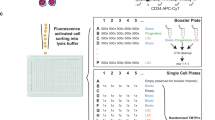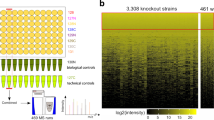Abstract
A major goal of biology is to provide a quantitative description of cellular behaviour. This task, however, has been hampered by the difficulty in measuring protein abundances and their variation. Here we present a strategy that pairs high-throughput flow cytometry and a library of GFP-tagged yeast strains to monitor rapidly and precisely protein levels at single-cell resolution. Bulk protein abundance measurements of >2,500 proteins in rich and minimal media provide a detailed view of the cellular response to these conditions, and capture many changes not observed by DNA microarray analyses. Our single-cell data argue that noise in protein expression is dominated by the stochastic production/destruction of messenger RNAs. Beyond this global trend, there are dramatic protein-specific differences in noise that are strongly correlated with a protein's mode of transcription and its function. For example, proteins that respond to environmental changes are noisy whereas those involved in protein synthesis are quiet. Thus, these studies reveal a remarkable structure to biological noise and suggest that protein noise levels have been selected to reflect the costs and potential benefits of this variation.
This is a preview of subscription content, access via your institution
Access options
Subscribe to this journal
Receive 51 print issues and online access
$199.00 per year
only $3.90 per issue
Buy this article
- Purchase on Springer Link
- Instant access to full article PDF
Prices may be subject to local taxes which are calculated during checkout




Similar content being viewed by others
References
Florens, L. et al. A proteomic view of the Plasmodium falciparum life cycle. Nature 419, 520–526 (2002)
Kumar, A. et al. Subcellular localization of the yeast proteome. Genes Dev. 16, 707–719 (2002)
Huh, W. K. et al. Global analysis of protein localization in budding yeast. Nature 425, 686–691 (2003)
Andersen, J. S. et al. Nucleolar proteome dynamics. Nature 433, 77–83 (2005)
Kellis, M., Patterson, N., Endrizzi, M., Birren, B. & Lander, E. S. Sequencing and comparison of yeast species to identify genes and regulatory elements. Nature 423, 241–254 (2003)
Ghaemmaghami, S. et al. Global analysis of protein expression in yeast. Nature 425, 737–741 (2003)
Wei, J. et al. Global proteome discovery using an online three-dimensional LC–MS/MS. J. Proteome Res. 4, 801–808 (2005)
Futcher, B., Latter, G. I., Monardo, P., McLaughlin, C. S. & Garrels, J. I. A sampling of the yeast proteome. Mol. Cell. Biol. 19, 7357–7368 (1999)
Gygi, S. P., Rochon, Y., Franza, B. R. & Aebersold, R. Correlation between protein and mRNA abundance in yeast. Mol. Cell. Biol. 19, 1720–1730 (1999)
Washburn, M. P. et al. Protein pathway and complex clustering of correlated mRNA and protein expression analyses in Saccharomyces cerevisiae. Proc. Natl Acad. Sci. USA 100, 3107–3112 (2003)
Schrödinger, E. What is Life? The Physical Aspect of the Living Cell (Cambridge Univ. Press, Cambridge, UK, 1944)
Barkai, N. & Leibler, S. Circadian clocks limited by noise. Nature 403, 267–268 (2000)
Balaban, N. Q., Merrin, J., Chait, R., Kowalik, L. & Leibler, S. Bacterial persistence as a phenotypic switch. Science 305, 1622–1625 (2004)
Samoilov, M., Plyasunov, S. & Arkin, A. P. Stochastic amplification and signaling in enzymatic futile cycles through noise-induced bistability with oscillations. Proc. Natl Acad. Sci. USA 102, 2310–2315 (2005)
Raser, J. M. & O'Shea, E. K. Noise in gene expression: origins, consequences, and control. Science 309, 2010–2013 (2005)
Novick, A. & Weiner, M. Enzyme induction as an all-or-none phenomenon. Proc. Natl Acad. Sci. USA 43, 553–566 (1957)
Ferrell, J. E. Jr & Machleder, E. M. The biochemical basis of an all-or-none cell fate switch in Xenopus oocytes. Science 280, 895–898 (1998)
Biggar, S. R. & Crabtree, G. R. Cell signaling can direct either binary or graded transcriptional responses. EMBO J. 20, 3167–3176 (2001)
Lahav, G. et al. Dynamics of the p53–Mdm2 feedback loop in individual cells. Nature Genet. 36, 147–150 (2004)
Eitzman, P. D., Hendrick, J. L. & Srienc, F. Quantitative immunofluorescence in single Saccharomyces cerevisiae cells. Cytometry 10, 475–483 (1989)
Edwards, B. S., Kuckuck, F. & Sklar, L. A. Plug flow cytometry: an automated coupling device for rapid sequential flow cytometric sample analysis. Cytometry 37, 156–159 (1999)
Becskei, A., Kaufmann, B. B. & van Oudenaarden, A. Contributions of low molecule number and chromosomal positioning to stochastic gene expression. Nature Genet. 37, 937–944 (2005)
Blake, W. J., Kaern, M., Cantor, C. R. & Collins, J. J. Noise in eukaryotic gene expression. Nature 422, 633–637 (2003)
Elowitz, M. B., Levine, A. J., Siggia, E. D. & Swain, P. S. Stochastic gene expression in a single cell. Science 297, 1183–1186 (2002)
Ozbudak, E. M., Thattai, M., Kurtser, I., Grossman, A. D. & van Oudenaarden, A. Regulation of noise in the expression of a single gene. Nature Genet. 31, 69–73 (2002)
Paulsson, J. Prime movers of noisy gene expression. Nature Genet. 37, 925–926 (2005)
Zaslaver, A. et al. Just-in-time transcription program in metabolic pathways. Nature Genet. 36, 486–491 (2004)
Cormack, B. P., Valdivia, R. H. & Falkow, S. FACS-optimized mutants of the green fluorescent protein (GFP). Gene 173, 33–38 (1996)
Shaner, N. C. et al. Improved monomeric red, orange and yellow fluorescent proteins derived from Discosoma sp. red fluorescent protein. Nature Biotechnol. 22, 1567–1572 (2004)
Wu, J. Q. & Pollard, T. D. Counting cytokinesis proteins globally and locally in fission yeast. Science 310, 310–314 (2005)
Hershko, A. & Ciechanover, A. The ubiquitin system. Annu. Rev. Biochem. 67, 425–479 (1998)
Wodicka, L., Dong, H., Mittmann, M., Ho, M. H. & Lockhart, D. J. Genome-wide expression monitoring in Saccharomyces cerevisiae. Nature Biotechnol. 15, 1359–1367 (1997)
Felice, M. R. et al. Post-transcriptional regulation of the yeast high affinity iron transport system. J. Biol. Chem. 280, 22181–22190 (2005)
Colman-Lerner, A. et al. Regulated cell-to-cell variation in a cell-fate decision system. Nature 437, 699–706 (2005)
Raser, J. M. & O'Shea, E. K. Control of stochasticity in eukaryotic gene expression. Science 304, 1811–1814 (2004)
Paulsson, J. Summing up the noise in gene networks. Nature 427, 415–418 (2004)
Fraser, H. B., Hirsh, A. E., Giaever, G., Kumm, J. & Eisen, M. B. Noise minimization in eukaryotic gene expression. PLoS Biol. 2, e137 (2004)
Ashburner, M. et al. Gene ontology: tool for the unification of biology. The Gene Ontology Consortium. Nature Genet. 25, 25–29 (2000)
Harbison, C. T. et al. Transcriptional regulatory code of a eukaryotic genome. Nature 431, 99–104 (2004)
Yu, L. & Morse, R. H. Chromatin opening and transactivator potentiation by RAP1 in Saccharomyces cerevisiae. Mol. Cell. Biol. 19, 5279–5288 (1999)
Huisinga, K. L. & Pugh, B. F. A genome-wide housekeeping role for TFIID and a highly regulated stress-related role for SAGA in Saccharomyces cerevisiae. Mol. Cell 13, 573–585 (2004)
Warner, J. R. Synthesis of ribosomes in Saccharomyces cerevisiae. Microbiol. Rev. 53, 256–271 (1989)
Fagarasanu, M., Fagarasanu, A., Tam, Y. Y., Aitchison, J. D. & Rachubinski, R. A. Inp1p is a peroxisomal membrane protein required for peroxisome inheritance in Saccharomyces cerevisiae. J. Cell Biol. 169, 765–775 (2005)
Holstege, F. C. et al. Dissecting the regulatory circuitry of a eukaryotic genome. Cell 95, 717–728 (1998)
Wang, Y. et al. Precision and functional specificity in mRNA decay. Proc. Natl Acad. Sci. USA 99, 5860–5865 (2002)
Acknowledgements
The authors acknowledge M. Bigos, P. Dezain and S. Elmes for their help with cytometry; K. Uffenheimer and A. Carroll (A.C.) for assistance with automation; W. Wickner for an anti-GFP antibody; R. Tsien for a construct encoding tdTomato; A.C., W.-K. Huh, M. Jonikas, V. Zapeda and E. Griffis for experimental assistance; A. H. DePace for graphical assistance; S. Collins, V. Denic, H. El Samad, V. L. Newman, E. K. O'Shea and members of the Weissman laboratory for insightful comments; and the Hertz Foundation, the NIH, DARPA and HHMI for funding.
Author information
Authors and Affiliations
Corresponding authors
Ethics declarations
Competing interests
Reprints and permissions information is available at npg.nature.com/reprintsandpermissions. The authors declare no competing financial interests.
Supplementary information
Supplementary Notes 1
Instruction manual for custom software described in the main text. Instructions on how to use ‘HTSPro’ to control the delivery of samples to a flow cytometer, as well as to control the software that runs the cytometer. As noted in the Supplementary Text, the software is available to academic users from the Authors. (PDF 8360 kb)
Supplementary Notes 2
Supplementary information about experimental design, execution and interpretation. Also provided is a supplementary discussion and supplementary figures that support the Main Text. (PDF 1125 kb)
Supplementary Table 1
Abundance and variation measurements for strains grown in YEPD and SD. (XLS 1672 kb)
Supplementary Table 2
Supplementary Table 2 nature04785-s04.xls Changes in protein and mRNA levels for strains grown in YEPD and SD. (XLS 195 kb)
Supplementary Table 3
Statistics for calculating the number of false positive and false negative strains. (PDF 46 kb)
Supplementary Table 4
Primers Used for Tagging and Deletion of ORFs (PDF 54 kb)
Supplementary Table 5
Organization of GO-Term, transcription factor and transcription module correlations associated with low or high variation (PDF 120 kb)
Supplementary Table 6
References for data used for P-value calculations (PDF 99 kb)
Rights and permissions
About this article
Cite this article
Newman, J., Ghaemmaghami, S., Ihmels, J. et al. Single-cell proteomic analysis of S. cerevisiae reveals the architecture of biological noise. Nature 441, 840–846 (2006). https://doi.org/10.1038/nature04785
Received:
Accepted:
Published:
Issue Date:
DOI: https://doi.org/10.1038/nature04785
This article is cited by
-
The fitness trade-off between growth and stress resistance determines the phenotypic landscape
BMC Biology (2024)
-
FOXO transcription factors as mediators of stress adaptation
Nature Reviews Molecular Cell Biology (2024)
-
Stability in gene expression and body-plan development leads to evolutionary conservation
EvoDevo (2023)
-
Microfluidic single-cell measurements of oxidative stress as a function of cell cycle position
Analytical and Bioanalytical Chemistry (2023)
-
Myxopyronin B inhibits growth of a Fidaxomicin-resistant Clostridioides difficile isolate and interferes with toxin synthesis
Gut Pathogens (2022)
Comments
By submitting a comment you agree to abide by our Terms and Community Guidelines. If you find something abusive or that does not comply with our terms or guidelines please flag it as inappropriate.



